On July 27, ADI China announced the latest ADPD7000 sensor front-end chip at a media sharing event. This chip plays a crucial role in monitoring vital signs such as heart rate, blood oxygen, and ECG in smartwatches. Aifou Technology was also honored to be invited to this media sharing event and learned a lot about the technology behind smartwatches and vital sign monitoring, which we would like to share with everyone.
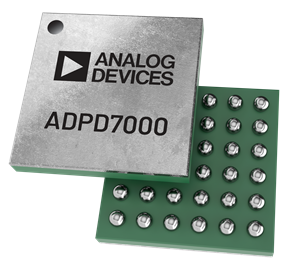
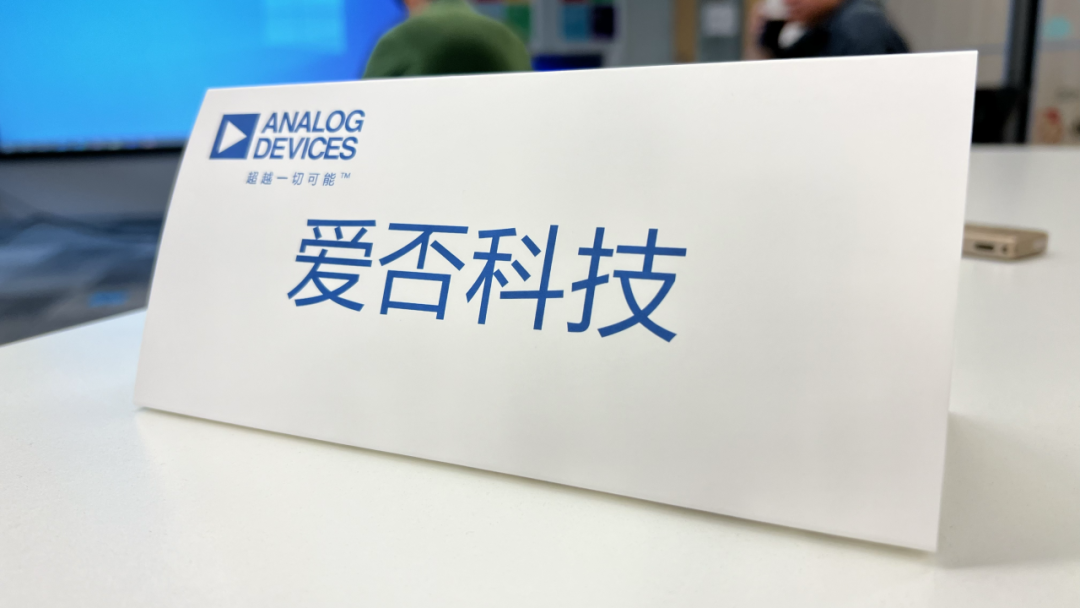
However, before discussing this chip, I would like to address the most concerning question: how is heart rate, blood oxygen, ECG, and body fat percentage detection achieved in smartwatches, and what are the underlying principles? Besides these familiar metrics, what other vital signs can current smartwatches monitor? Are they accurate?

Heart Rate
Heart rate monitoring is currently the most mature and convenient feature, and it is a basic function of every smartwatch. The principle behind its implementation on the watch is quite simple: by shining a beam of light onto the blood vessels in the wrist and observing the periodic changes in the reflected light caused by blood flow, the heart rate can be calculated.
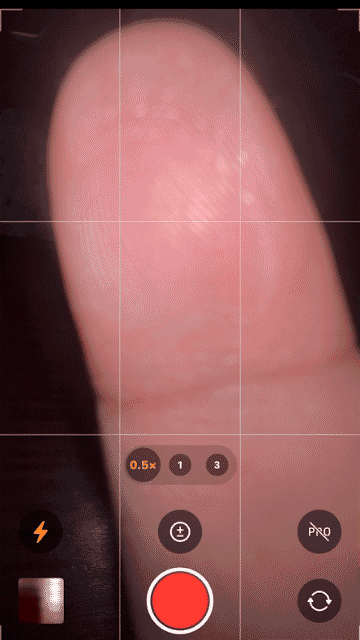
You can open your phone’s camera and flashlight, placing your finger over the camera closest to the flashlight. In the footage captured by the camera, you will see variations in color caused by the reflected light, which corresponds to your pulse. By calculating the average brightness of the image, you can obtain a curve of your pulse (blood flow changes). Each peak represents one heartbeat.

Image from the internet
In fact, some early heart rate detection mobile apps used this method. However, due to power consumption considerations, smartwatches do not use cameras and flashlights for heart rate detection; instead, they use dedicated hardware—LED lights and photodiodes. This results in higher efficiency and accuracy.
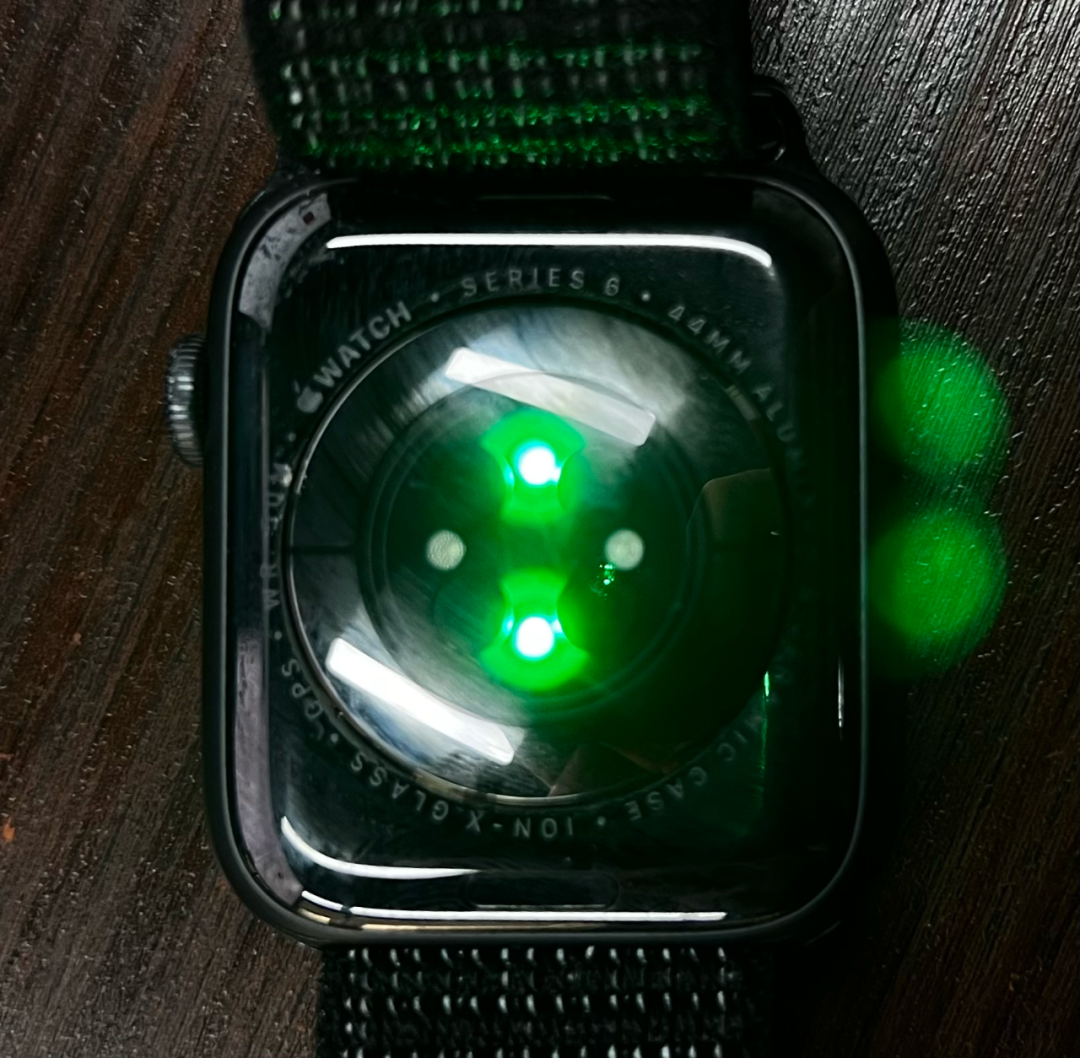
LED responsible for heart rate detection on the Apple Watch
This optical heart rate detection technology is known as “Photoplethysmography (PPG).” It has matured significantly, achieving high accuracy under ideal conditions. Medical pulse oximeters use this technology, but they typically employ a transmission method that allows light to pass through the finger, yielding higher quality information that is easier to measure accurately. In contrast, the wrist’s thickness makes it difficult for light to penetrate, so a reflection method is used, resulting in extremely weak raw signals, making accurate measurement more challenging.

Heart Rate Variability (HRV)
PPG can not only obtain heart rate but also other valuable information related to the heart. Remember the curve we just mentioned?

The “curve” obtained by the PPG method actually reflects the dynamic trend of blood flow over time, so we can not only calculate heart rate from this information but also derive another important health parameter: heart rate variability (HRV), which is the small differences in time intervals between each heartbeat (the changes in the R-R interval shown in the figure). There are various methods to calculate HRV, but the method used in smartwatches is generally the standard deviation. This data is related to stress levels and cardiovascular health.
People have different heart rates under different exercise states, and the autonomic nervous system, also known as the “vegetative nervous system,” regulates heart rate changes. It is divided into the sympathetic and parasympathetic nervous systems. The processed HRV data can reflect the working state of the autonomic nervous system. To put it simply, heart rate is like the speed of a car, while HRV corresponds to how sensitive the brakes and accelerator are.
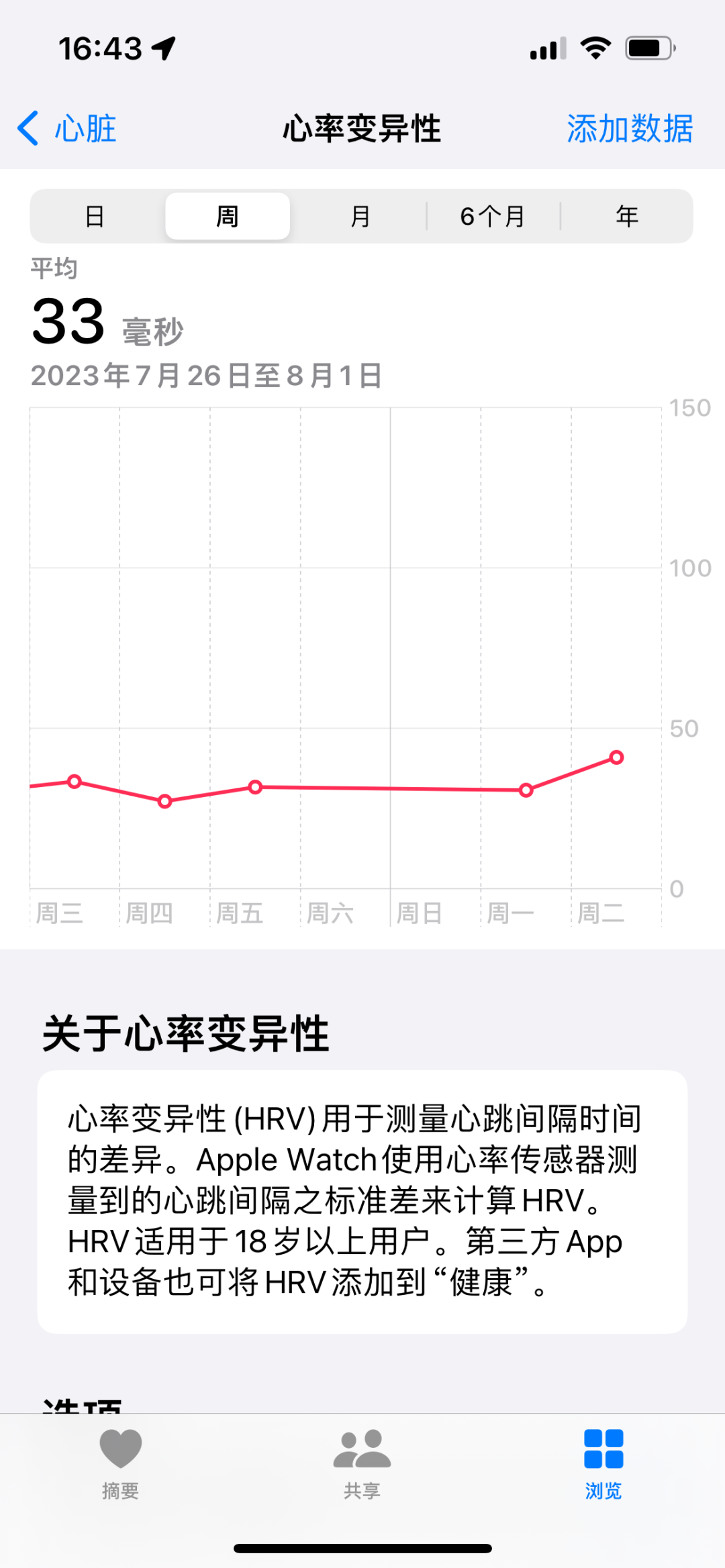
HRV data tracked by the Apple Watch
Generally speaking, the higher the HRV within a reasonable range, the better the user’s physical condition. Of course, the HRV measured by smartwatches has certain limitations, but tracking an individual’s HRV trend over time can greatly assist in assessing the user’s overall health, something traditional medical devices cannot achieve.

Blood Oxygen
Using the PPG method, another important vital sign that can be detected is blood oxygen saturation, which indicates the concentration of oxygen in the blood. This data directly reflects whether the user is experiencing hypoxia. Generally, in flatland areas, normal blood oxygen saturation is 100%; below 90% indicates some hypoxia symptoms, while below 80% indicates severe hypoxia.
The direct measurement of blood oxygen saturation is done by collecting blood samples from the arteries and using a blood gas analyzer. Currently, the principle behind blood oxygen monitoring in smartwatches is based on the different absorption rates of oxygenated hemoglobin (HbO2) and deoxygenated hemoglobin (Hb) for red and infrared light. By shining red and infrared light onto the skin and comparing the results returned from both, blood oxygen levels can be calculated through algorithms. If you wear an Apple Watch, you may notice the wrist lights up with red light when it is conducting a blood oxygen test in a dark environment while you are still.
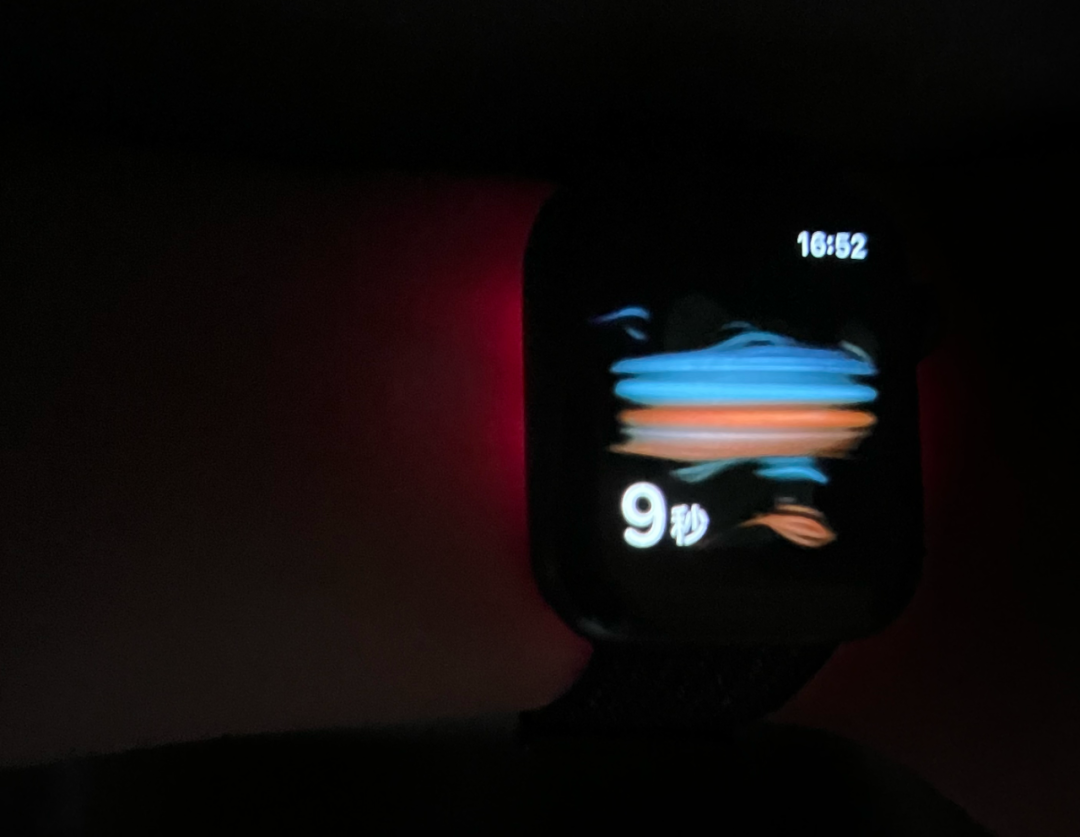
Compared to heart rate detection, the accuracy of blood oxygen monitoring on smartwatches is generally lower (especially with extreme data). This is because the signals are weaker and more susceptible to complex environmental influences, requiring stricter hardware and user operation standards. Therefore, most smartwatch devices require users to remain still during blood oxygen detection, which can lead to a certain failure rate, and it is also challenging to achieve real-time continuous monitoring.
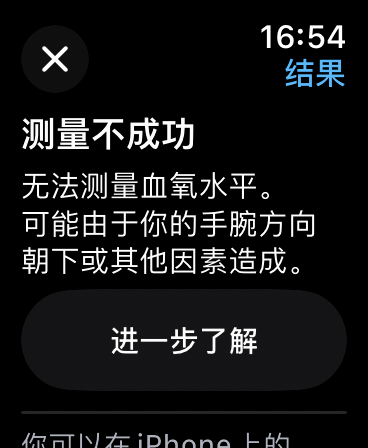
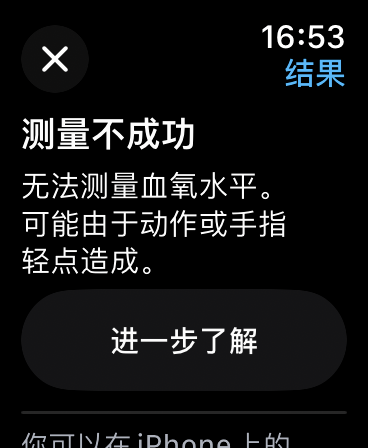
Because the accuracy of blood oxygen detection on smart devices is still difficult to reach true medical-grade levels, its greatest significance for the average person is not long-term monitoring trends or assessing health status, but providing real-time alerts for “hypoxia,” a condition that is easily overlooked in its early stages but can have serious consequences when discovered.
For example, two years ago, I was resting in a vehicle at an altitude of 5000m, and due to low temperatures and poor ventilation, I experienced some hypoxia symptoms. My Apple Watch alerted me that my blood oxygen level was 66% (which was not actually that low; based on symptoms, it was about 85%). When I received the notification and woke up, I indeed had a severe headache, and the blood oxygen detection function helped me avoid a potential health risk.
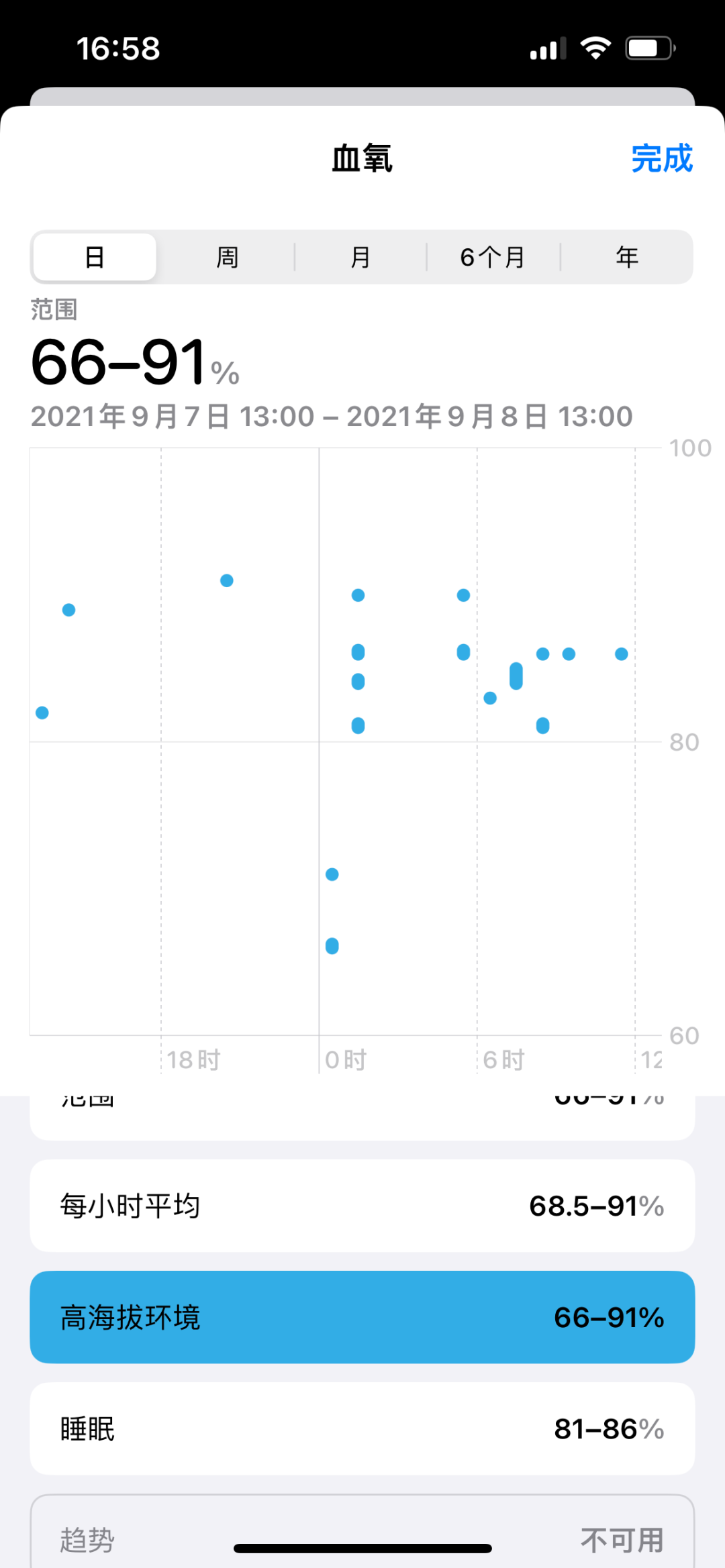
The above metrics are all obtained through optical methods. Next, let’s discuss the vital sign information that can be obtained through collecting electrical signals from the body.

Electrocardiogram (ECG)
You should be familiar with ECG, as it is performed during health check-ups. It involves placing multiple electrodes at specific locations on the body to capture and amplify weak electrical signals from the heart, which are then recorded. Professional doctors can diagnose heart health by reviewing the ECG information.
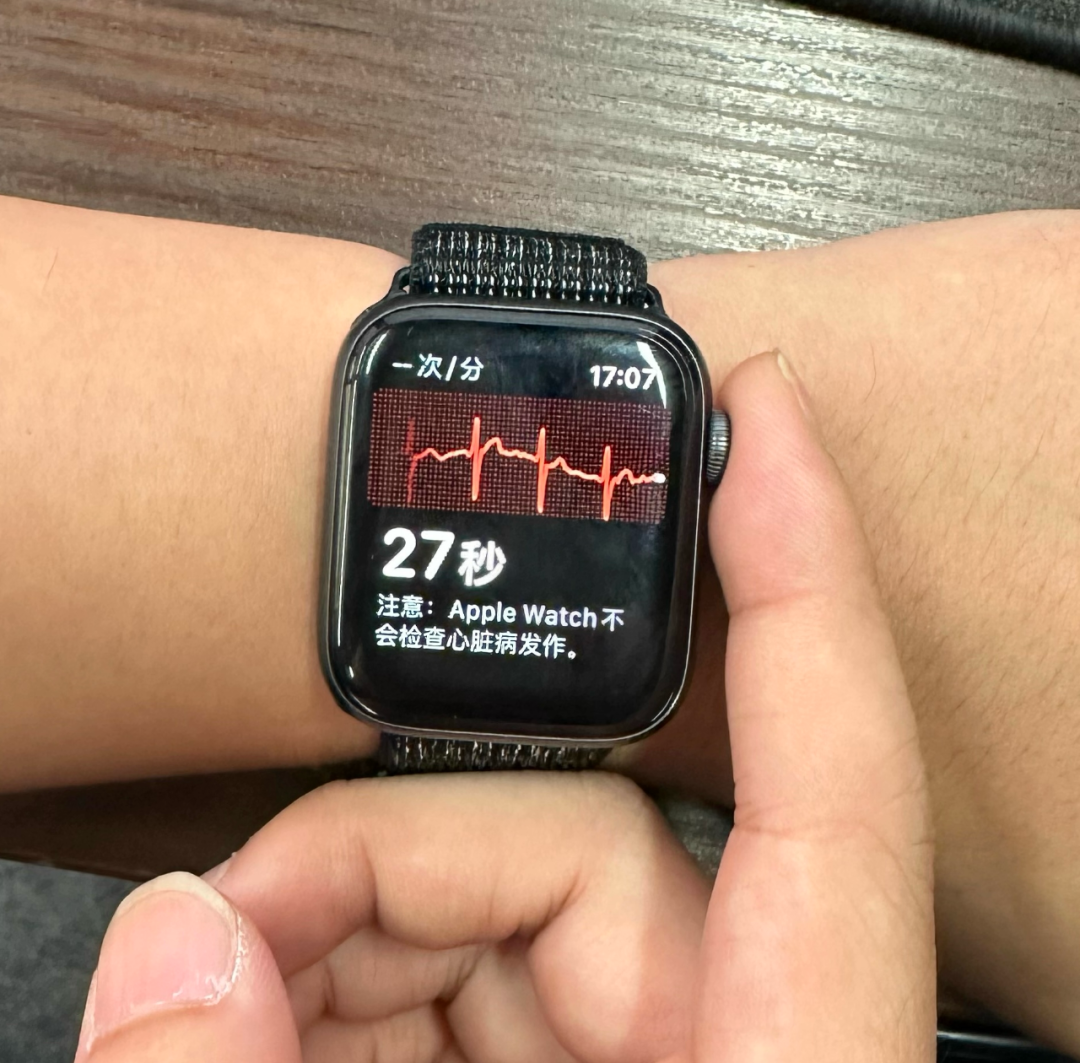
However, unlike the twelve-lead ECG performed in medical institutions, most smartwatches, due to form factor limitations, are equipped with single-lead ECG functionality, which only captures a single circuit between the two hands, resulting in limited dimensions of the ECG information and only able to reflect a few heart issues. Currently, most can only determine sinus arrhythmia and atrial fibrillation, and they require users to actively initiate the test. For most users with healthy heart function, this feature is typically only used frequently in the first month or two after purchasing the watch, after which it is rarely utilized.
However, this does not mean that the ECG function on the watch is a “placebo.” Most watches that support ECG functionality will detect signs of arrhythmia during regular optical heart rate monitoring, but the information obtained through optical methods is limited and has a certain false positive rate. It can only prompt users to actively capture a more accurate ECG after multiple confirmations of significant signs. If the ECG confirms a high probability of arrhythmia or atrial fibrillation, it will prompt users to seek medical diagnosis early to avoid more serious issues.
The purpose is not to have users perform ECGs daily to confirm their heart health; rather, the greatest significance of this feature for the average person is prevention, providing a form of “insurance.” In other words: if the watch indicates that your heart is fine, it does not guarantee that it is truly healthy, but if the watch indicates that there is a problem, it is likely that there is indeed an issue.

Body Composition Measurement
Also using electrical measurement methods, body composition measurement, especially body fat percentage measurement, is more practical for most users. This feature is familiar to everyone from body fat scales, which measure the body’s bioelectrical impedance (BIA) by passing a weak current through electrodes into the body. By substituting a series of impedance values into corresponding height, weight, and gender models, it can calculate body composition information, including body fat, body water content, and lean body mass.
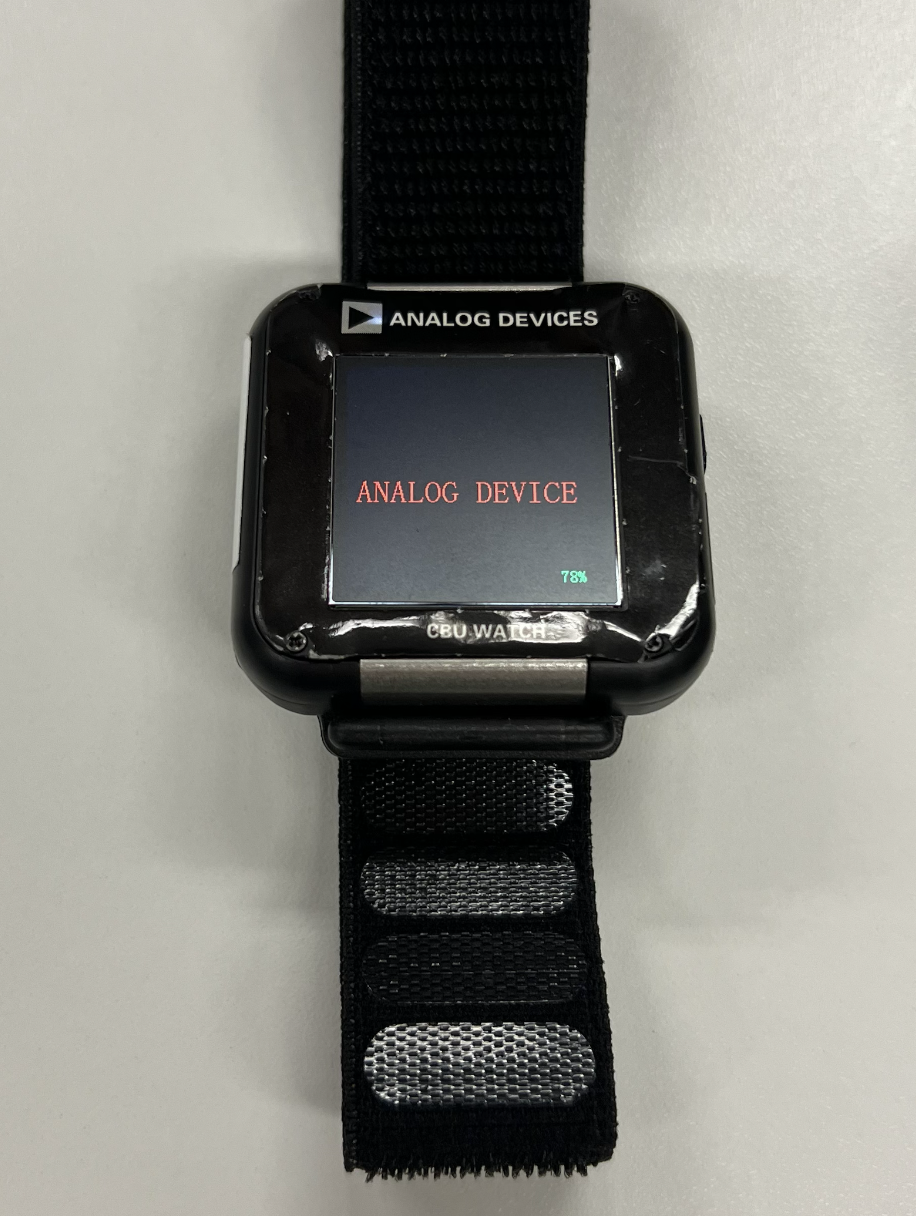
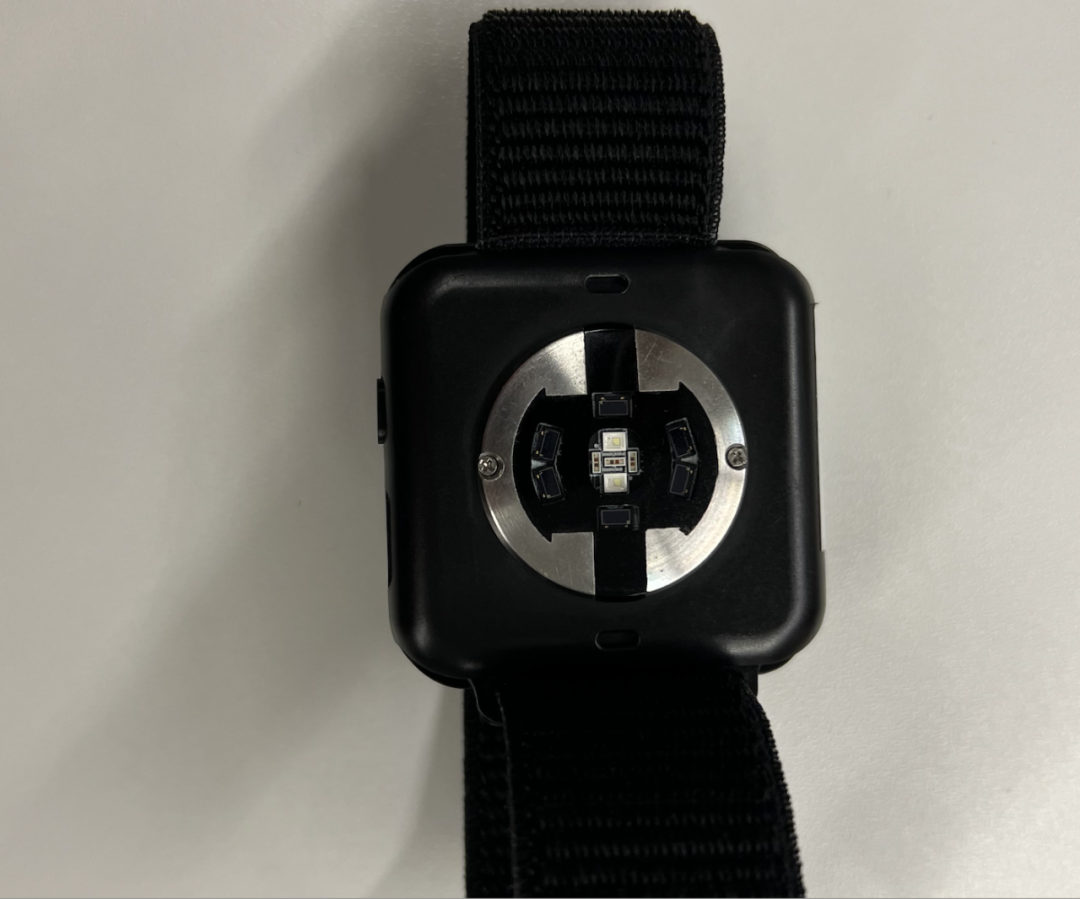
ADPD7000 demo smartwatch
At this ADPD7000 demo smartwatch event, I and several media colleagues experienced the body composition measurement feature and compared it with the data from professional body composition analyzers on-site. The difference in body fat percentage was generally within 2% (approximately 7% error), and I personally found the demo watch’s results to be very stable, with multiple tests showing a difference of less than 0.5% (approximately 2% error).
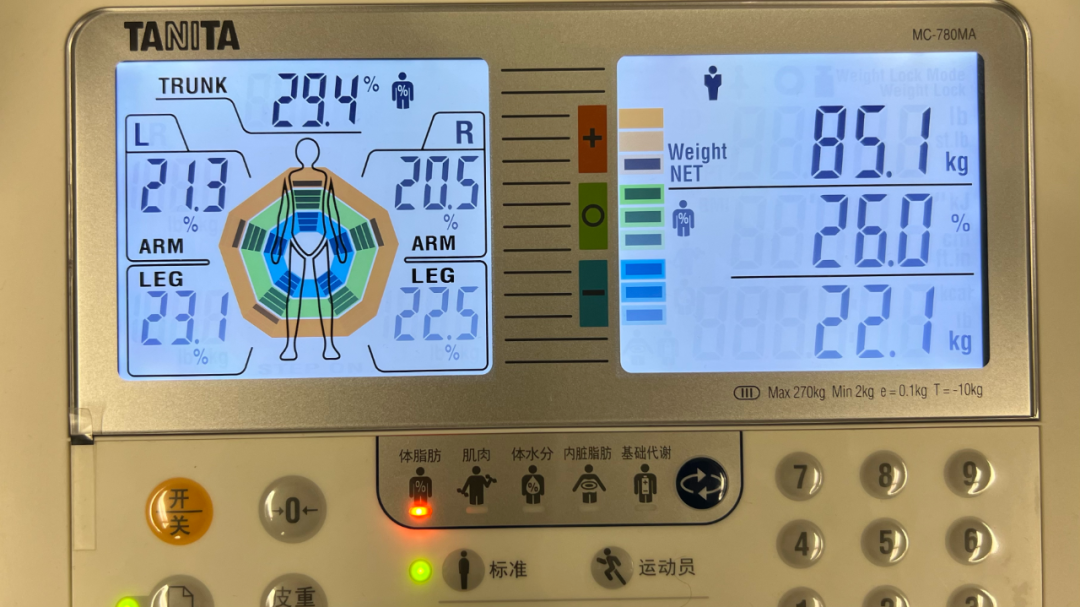
Data from a professional eight-electrode body composition analyzer (26%)
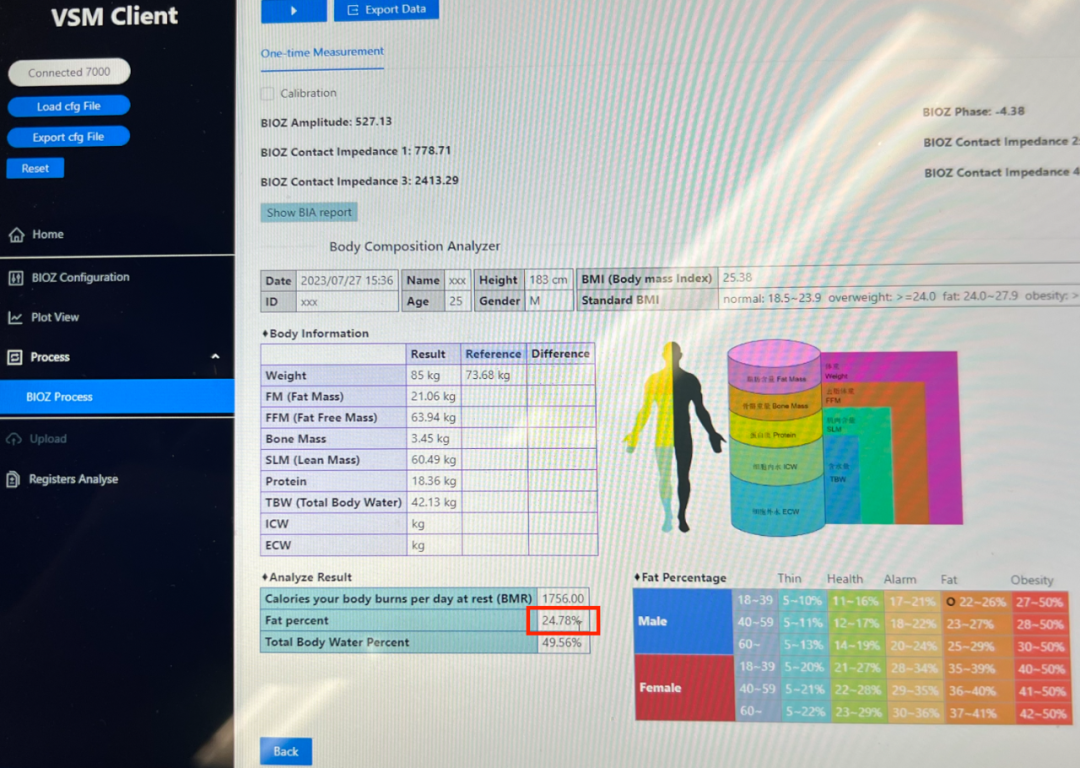
Data obtained from the ADI Demo Watch (24.78%)
At least from this small sample of data, smartwatches equipped with the ADPD series chip that have body fat detection functionality already have a certain reference value. The body composition measurement feature on Samsung’s Galaxy Watch 4 and 5 is also powered by the previous generation of the ADPD series.
Compared to body fat scales, measuring body fat with a smartwatch does not require removing shoes or socks. The entire process only requires the other hand to grasp the two electrodes on the watch, waiting for about 3 seconds to obtain complete body composition measurement data. This is a more convenient option for fitness enthusiasts.
ADPD 7000

The component responsible for driving the various optical and electrical signal emitters above and converting the analog signals received by the sensors into digital signals is the star of today’s event: the ADPD7000 multimodal sensor front-end chip developed by ADI China.
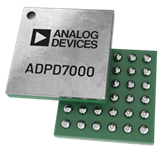
This analog chip includes 8 LED drivers, 4 optical input channels for PPG (optical measurement), 1 set of 4-electrode ECG (electrocardiogram) channels, a BIA (bioelectrical impedance) channel, a GSR (galvanic skin response) channel, as well as corresponding ADC, clock, filtering, and other circuits. It is responsible for driving the LED components and processing the raw sensor signals into high-quality digital signals to be sent to the watch’s SoC for processing. All of this is encapsulated in a volume of just 2.8×2.6×0.4mm, about the size of two sesame seeds.
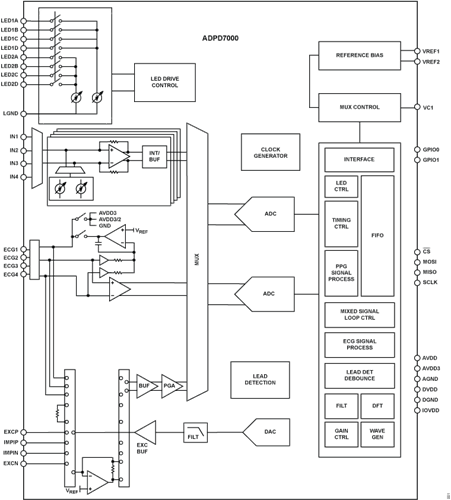
Functional framework diagram of the ADPD7000
Sometimes one cannot help but marvel at the progress of modern technology, allowing smartwatches to gradually achieve the functions of medical devices that once weighed dozens of kilograms within such a small volume.
The first upgrade of the ADPD7000 compared to its predecessor, the ADPD6000, is that the number of LED drivers has increased from 4 to 8. The increase in the number of LED drivers means that this chip can support more sets of PPG sensors.
Do you remember the statement we mentioned earlier: “Under ideal conditions, PPG is already accurate enough”? More sensors are not solely for improving accuracy; they are also aimed at enhancing stability under “non-ideal conditions.”
A smartwatch with a single PPG sensor will not have significant issues measuring heart rate when the wearer is sitting still, but once in motion, the sensor’s position may shift, degrading the quality of the data obtained. When the wearer has tattoos or dense body hair, similar issues may arise. However, multiple sensors provide redundancy, ensuring that under these complex conditions, at least one set can obtain high-quality data. Most smartwatches that prioritize measurement accuracy will have such designs with multiple redundant sensors, which requires the front-end chip to have more channels for driving and input capabilities.
The second upgrade is the addition of a skin electrical signal (GSR) measurement channel. This channel reuses some circuits from the ECG and BIA.
You may be unfamiliar with skin electrical signals, but you often see them in movies as part of lie detectors, which measure one parameter: skin electrical signals. The earliest lie detectors determined whether a person was lying by measuring heart rate and respiratory rate, as most people experience increased heart rate and respiratory rate when lying. However, it was later discovered that some “trained” individuals could maintain a calm demeanor while lying, resulting in little change in heart rate and respiratory rate. Skin electrical response and sweating, being directly controlled by the autonomic nervous system, are less influenced by consciousness and harder to conceal. Thus, it has always been an important parameter used in lie detectors. Of course, to improve accuracy, modern lie detectors have also incorporated measurements of voice, body movement, and other dimensions.
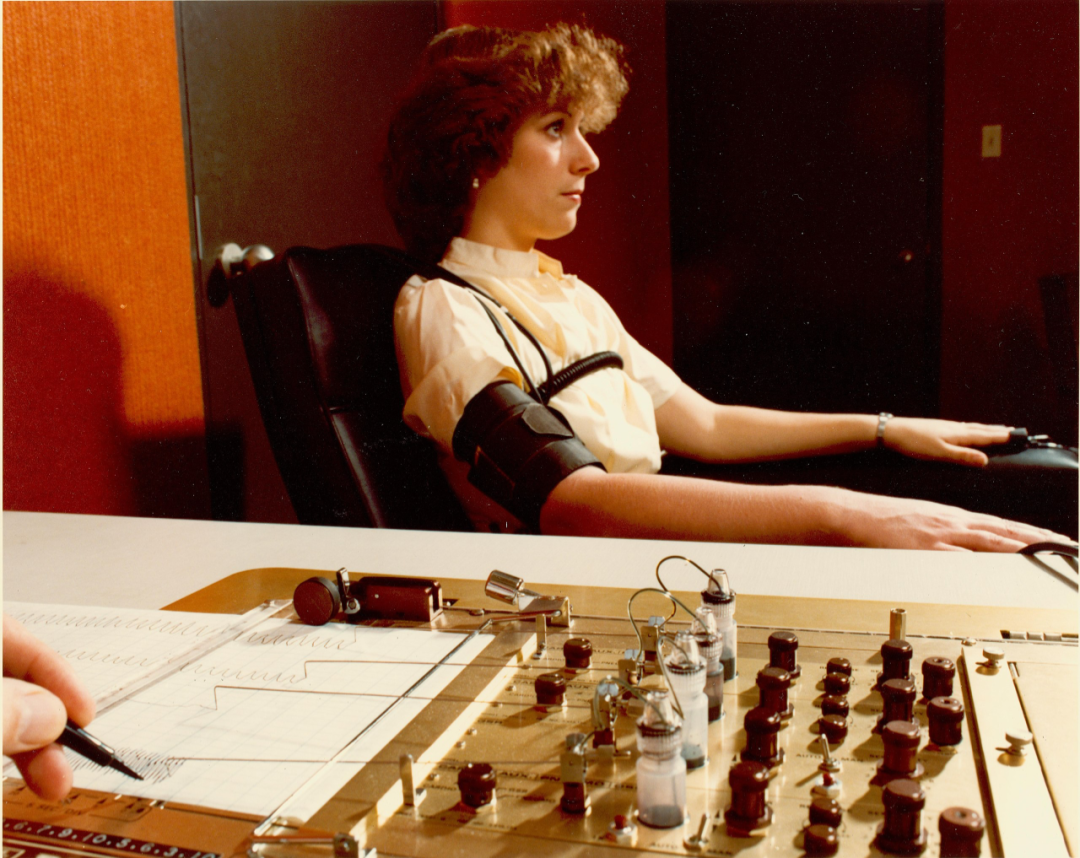
Early lie detectors, image from the internet
Aside from its use in “lie detection,” skin electrical response has significant value in assessing human emotions, especially levels of tension and stress. By combining and analyzing data with heart rate and heart rate variability, some smartwatch products can objectively quantify user stress levels.
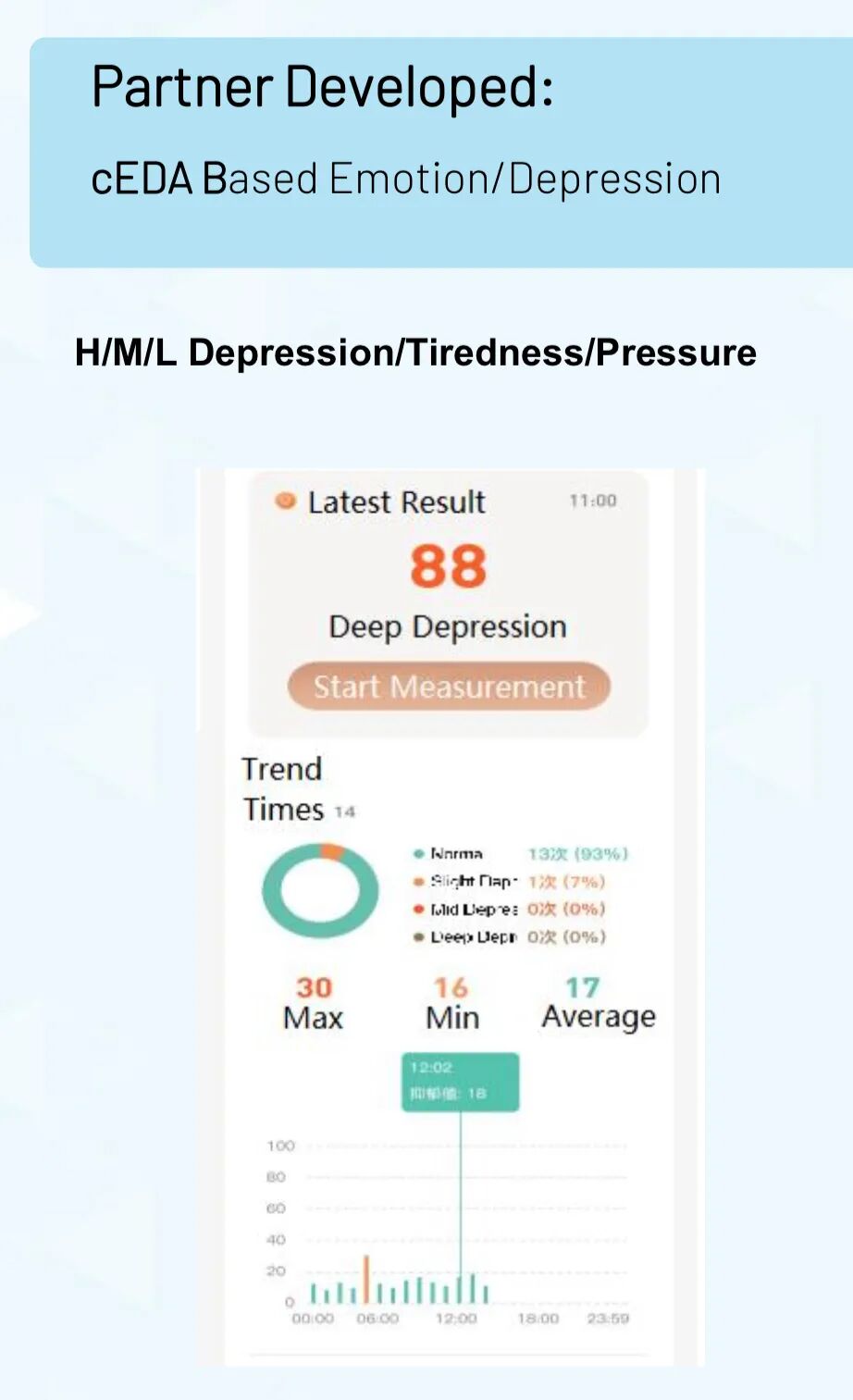
Stress/depression risk assessment conducted using ADI chip-equipped wearable devices
Of course, human emotions and stress are also influenced by subjective factors, making it a complex issue. Skin electrical activity and parameters like heart rate can only reflect certain dimensions, and a more reliable relationship between the two requires extensive data analysis to establish a model. However, I believe that with the development of technology, measuring emotions and stress will become increasingly accurate. I personally speculate that Apple’s “emotion recording” feature introduced in iOS and watchOS at this year’s WWDC may be collecting data, and in the future, emotions and stress may be automatically detected by the watch without manual recording.


New “emotion recording” feature in iOS 17
This aspect tests the algorithm accumulation of smartwatch manufacturers, while for a sensor front-end chip, the goal is to provide the highest quality raw data possible. We also experienced the measurement of raw skin electrical signal data on the demo watch. I wore the demo watch and deliberately created some highly tense situations that would increase skin electrical activity: playing a rhythm game.
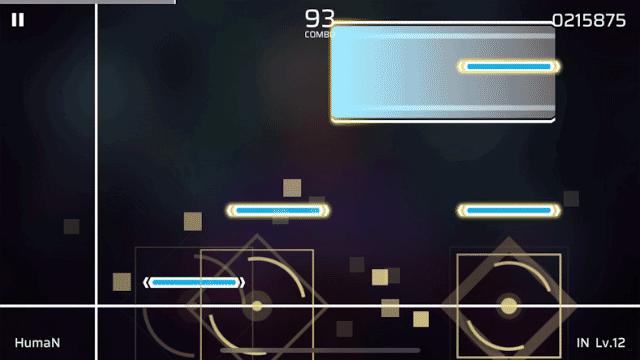
In the rhythm game, to achieve a higher score and maintain a FULL COMBO, one must stay highly focused. From the graph, it can be seen that after the game started, skin electrical activity remained elevated, indicating continuous tension and stimulation, which aligns with the nature of such games (laughs). Unfortunately, due to time constraints, we could not conduct more complex tests. “If we could wear this watch while playing a round of CSGO, I believe the values would differ significantly between a 1v5 situation and when spectating.”
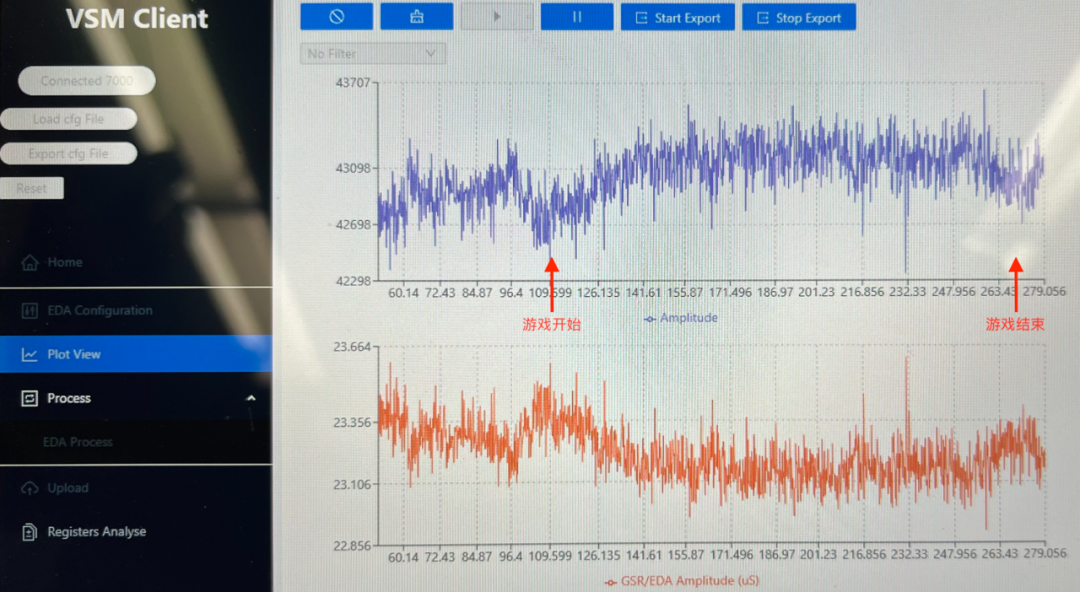
Additionally, this chip has improved the signal-to-noise ratio of some circuits compared to its predecessor, which is easy to understand. Under the same power consumption for LED emission, a higher signal-to-noise ratio helps obtain better signal quality, enhancing measurement accuracy, especially in complex environments such as dry skin or darker skin tones. At the same accuracy level, it can reduce the power of LED emissions, saving precious battery life for the watch or increasing measurement frequency to obtain more detailed data.
Outlook

Aside from the mature functions mentioned above, I am personally very interested in some “future functions” that are not yet widely commercialized or are still in development but could significantly impact our lives. During the Q&A session after the event, I asked He Yuan, the Senior Market Application Manager of ADI China, about these two questions to see what conveniences smartwatches might bring us in the future.
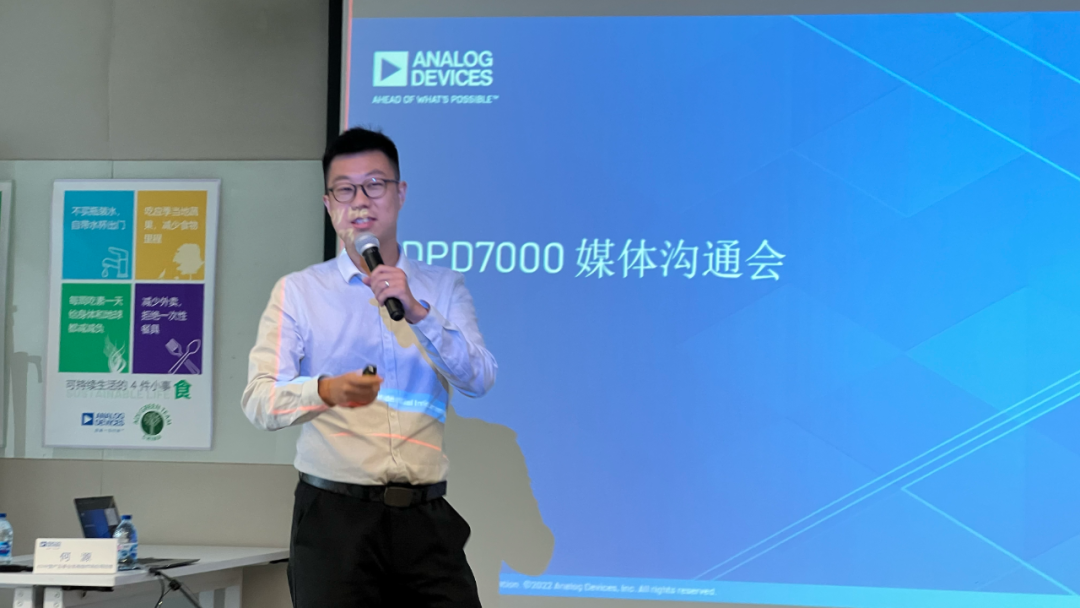
He Yuan, Senior Market Application Manager of ADI China
Ten Days:“Last year, when I participated in your company’s ADPD 6000 series media sharing event, I learned that smartwatches can now perform cuffless blood pressure monitoring (CNIBP) without needing to inflate a cuff. This feature, if widely commercialized, would greatly benefit those with hypertension. How is it achieved, and why is it not yet widely commercialized?”
He Yuan:“There are two ways to achieve cuffless blood pressure monitoring: one is through PPG, establishing a relationship between optical signals and blood pressure. The other is a combination of optical and electrical signals, detecting the time difference between the optical and electrical signals reflecting blood flow and heart action to infer blood pressure. We already have partners who have developed corresponding products, and the hardware is ready, but before large-scale commercialization, we need a lot of data from patients with high (low) blood pressure for validation to ensure accuracy and effectiveness. Unlike heart rate, exercise capacity, and body fat, which can collect information from a broad population, this data is relatively difficult to gather.”
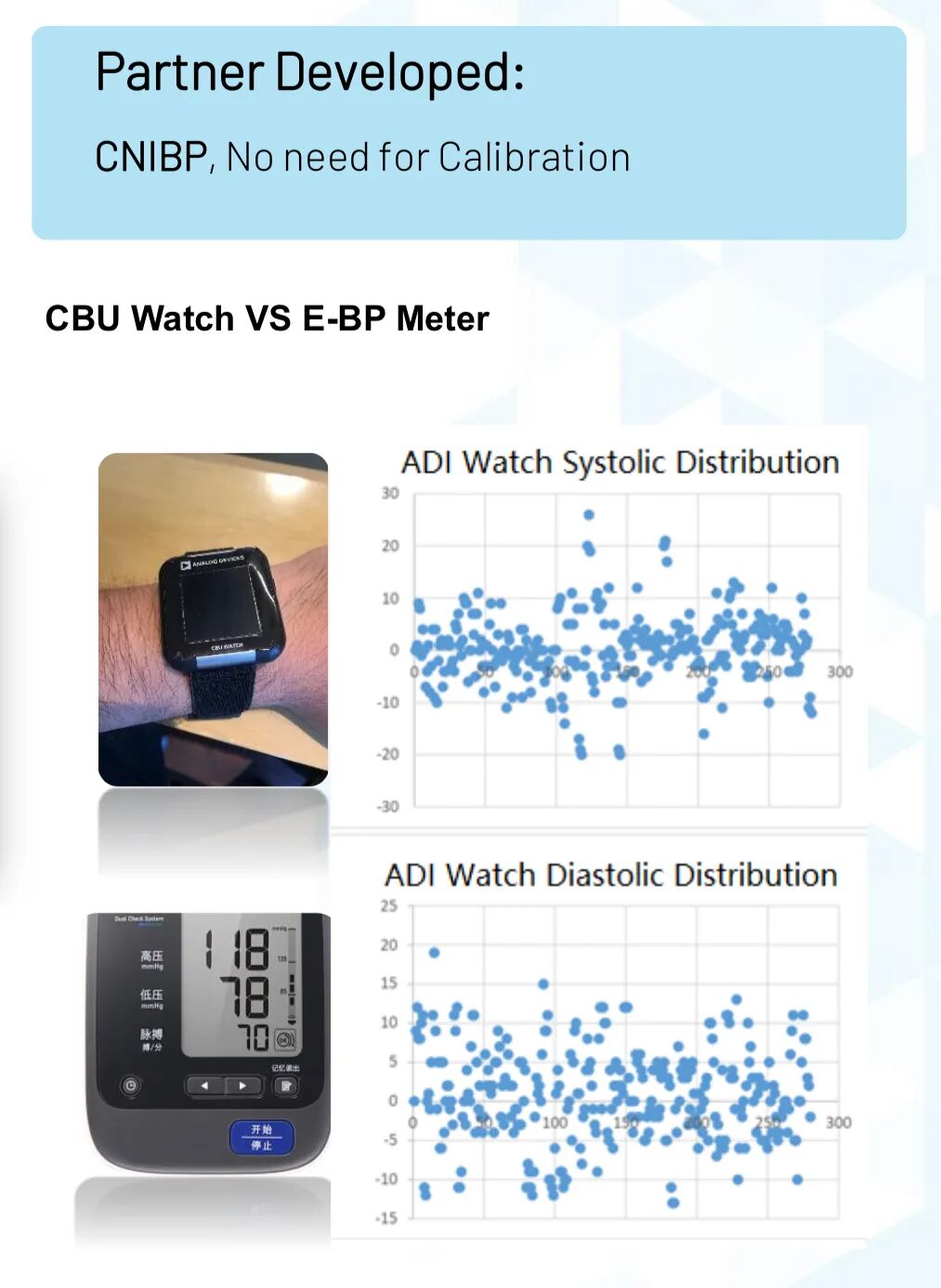
Data comparison of cuffless blood pressure monitoring using ADI chip-equipped watches and blood pressure monitors
Ten Days:“The addition of skin electrical monitoring in the ADPD7000 is very interesting. Can smartwatches equipped with this feature interact with smart home devices like air conditioners? When I exercise at home and start sweating, or when I suddenly feel anxious and start sweating while sitting, I have to manually adjust the air conditioning. Is it possible in the future to use the watch to monitor skin electrical signals, body temperature, heart rate, and other vital signs to make air conditioning smarter, eliminating the need for manual adjustments?”
He Yuan:“What you mentioned is very likely to be realized; the principle is feasible. Skin electrical signals can effectively reflect sweating, and combined with heart rate, HRV, and temperature data, it can determine whether a person feels hot. It can adjust the air conditioning based on your physical state. Not only this, but in the future, it may also interact with cars, treadmills, and other devices, allowing them to better understand your condition and adjust automatically. However, this will require many applications and algorithms to adapt. We can only say that our hardware currently has the capability, but when and how specific products will be released, and their reliability, will depend on the calibration capabilities of the terminal manufacturers.”
Perhaps in a few years, our lives will be as He Yuan said: “Your watch may understand you better than you do.” Smartwatches will not only provide more comprehensive health advice but also intelligently know what you need at any given moment without requiring you to lift a finger or say a word, making our lives more intelligent.
Throughout this process, we will continue to witness the progress of this industry, focusing not only on the final products but also on suppliers like ADI, paying attention to the development of underlying technologies and chips.
Note:
1. The author of this article is not a medical professional, and the medical and health information mentioned in the article cannot guarantee rigor and may not apply to everyone. It is for the technical popularization of smart wearable device technology. If there are any errors, please criticize and correct! For specific health or medical issues, please consult relevant professionals.
2. Health monitoring by smart wearable devices has certain limitations; please refer to relevant medical certifications.
3. The views expressed in this article do not represent those of ADI, and ADI has not influenced Aifou Technology’s views.
4. The Apple Watch used in this article is for demonstration purposes only and does not represent the use of ADI’s related technologies or products.

Written by / Ten Days
Edited by / Kailun
Reviewed by / Kailun
© Aifou Technology original content, please contact the backend for reprints